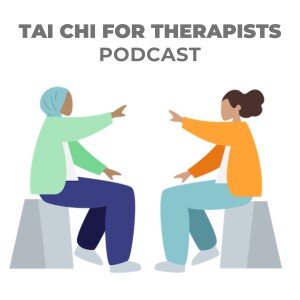
Friday Sep 06, 2024
Ep.03 Tai Chi In A Chronic Pain Service
In this podcast we interview Carole Edin, an Occupational Therapist based in Leeds. Carole implements tai chi and qigong movements into her clinical practice with patients in a local chronic pain service.
Guest Profile
Interview Summary
1. Chronic Pain Management Approach:
- Focus on self-management and self-compassion
- Emphasize pacing activities and avoiding "boom and bust" cycles
- Incorporate sleep hygiene, diet, and nutrition advice
- Address emotional well-being and stress management
2. Introduction of Tai Chi in Pain Management:
- Present Tai Chi as "enjoyable movement" rather than exercise to reduce fear-avoidance
- Start with seated movements, progressing slowly to standing
- Emphasize gentle, slow motions and individual adaptation
- Incorporate relaxation and tension-spotting techniques before and after practice
3. Benefits of Tai Chi for Chronic Pain Patients:
- Improves relaxation and stress reduction
- Enhances mobility and function
- Potential for medication reduction
- Particularly beneficial for conditions like fibromyalgia
4. Implementation Strategies:
- Tailor approaches to individual patients and their specific conditions
- Use visualization techniques for patients unable to perform physical movements
- Introduce Tai Chi gradually, emphasizing regular practice over duration
- Combine Tai Chi with other pain management strategies (described as a "jigsaw puzzle" approach)
5. Group vs. Individual Sessions:
- Adapt instructions for group settings, encouraging individual modifications
- Emphasize non-competition and personal progress
6. Practitioner Benefits:
- Potential for personal health improvements, including coordination
- Use as a self-care tool for healthcare professionals
7. Evidence-Based Practice:
- Incorporate research on Tai Chi's benefits, particularly for conditions like fibromyalgia
- Consider Tai Chi as part of a multidisciplinary approach to pain management
8. Patient-Centered Outcomes:
- Focus on improving quality of life and expanding activities despite pain
- Encourage reintroduction of enjoyable activities and socialization
9. Professional Development:
- Chronic pain management offers diverse and rewarding career opportunities
- Continuous learning due to varied patient presentations and conditions
In Summary
Health professionals should consider integrating Tai Chi as a complementary approach in chronic pain management, focusing on gradual introduction, individualisation, and combining it with other evidence-based strategies for optimal patient outcomes.
Bonus downloads kindly provided by Carole.
Listen, rate, and subscribe.
Have you enjoyed this episode? Then you may like to rate and subscribe so that you can enjoy more podcasts as we release them.
Would you like to find out more about our class leading CPD course for health professionals: Tai Chi for Therapists.
We created this course for all registered allied health professionals, clinicians, and other rehabilitation professionals who would like to learn how to implement evidence-based tai chi and qigong movements into their clinical practice.
If you’re a physiotherapist, physical therapist, occupational therapist, occupational or physiotherapy assistant, or other allied health professional visit our course page to find out more.
We look forward to seeing you,
Phil & Helen
Website: www.taichifortherapists.com
No comments yet. Be the first to say something!